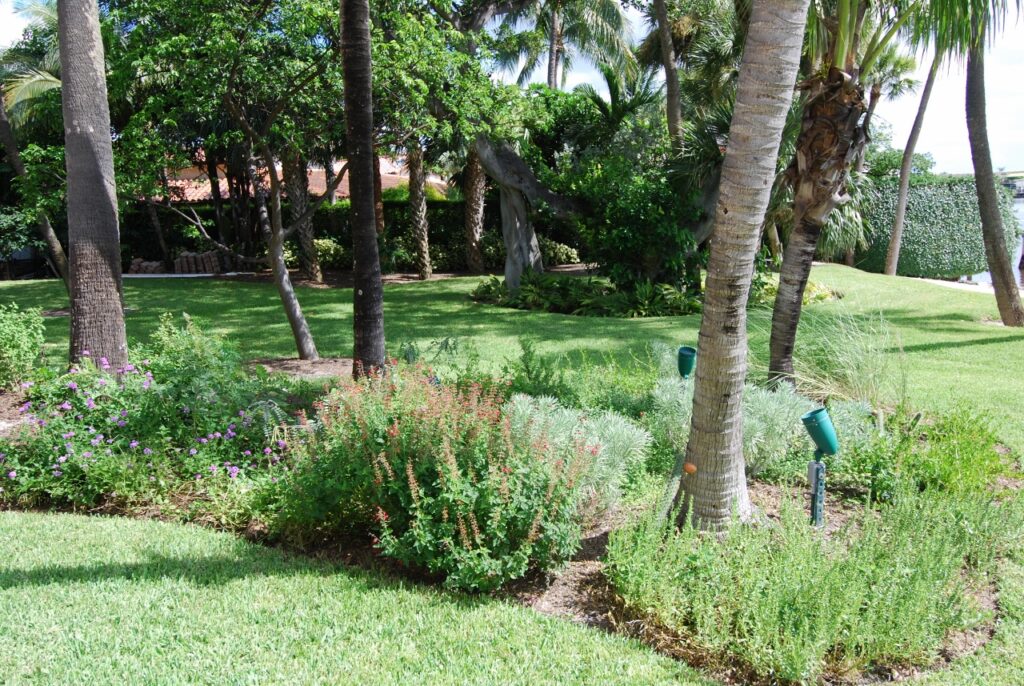
This planting is 100 feet west of the intracoastal waterway in Lantana Florida. This is a mixture of wind and salt tolerant Sea Lavender, Red Salvia, Beach Elder, Beach Verbena, Southern Beebalm, Seaside Goldenrod, Beach Creeper and Sand Cordgrass.

This planting is 100 feet west of the intracoastal waterway in Lantana Florida. This is a mixture of wind and salt tolerant Sea Lavender, Red Salvia, Beach Elder, Beach Verbena, Southern Beebalm, Seaside Goldenrod, Beach Creeper and Sand Cordgrass.
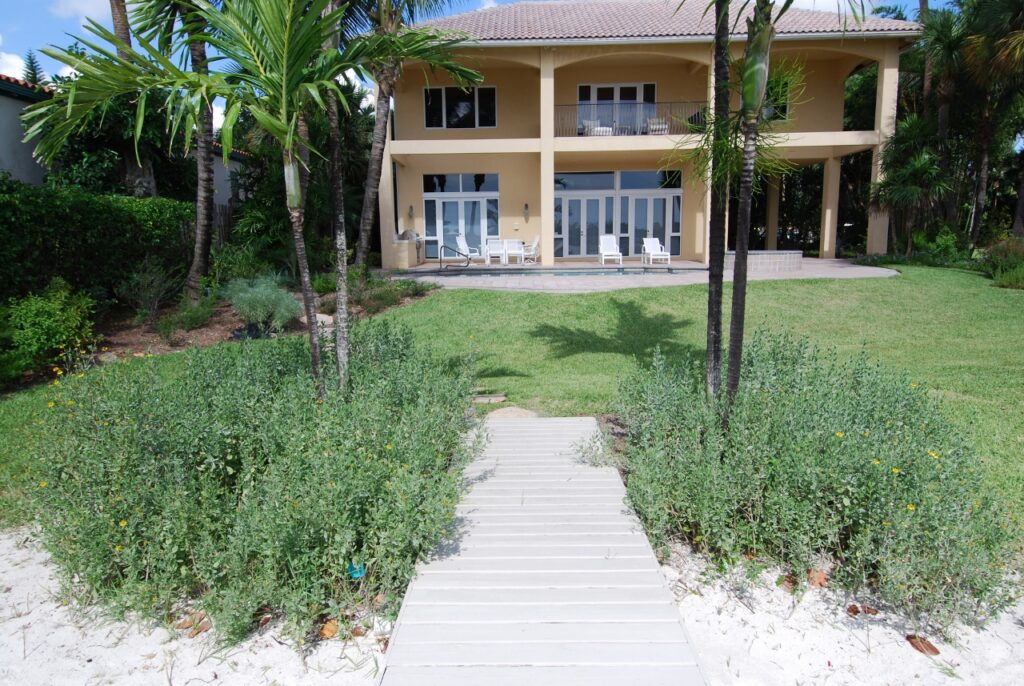
Bob West side of Intracoastal at Six Months
Ugly Cardboard Palms were removed from this site: a beach on the west side of the intracoastal, and replaced with Silver Sea Oxeye Daisies. These have yellow flowers and thistle sized seeds that feed buntings and other seed eating birds.
This is a very difficult site to plant due to the strong winds blowing salt air and water onto these plants in the fall. Silver Sea Oxeye Daisies naturally grow in this exact location with mangroves as neighbors.
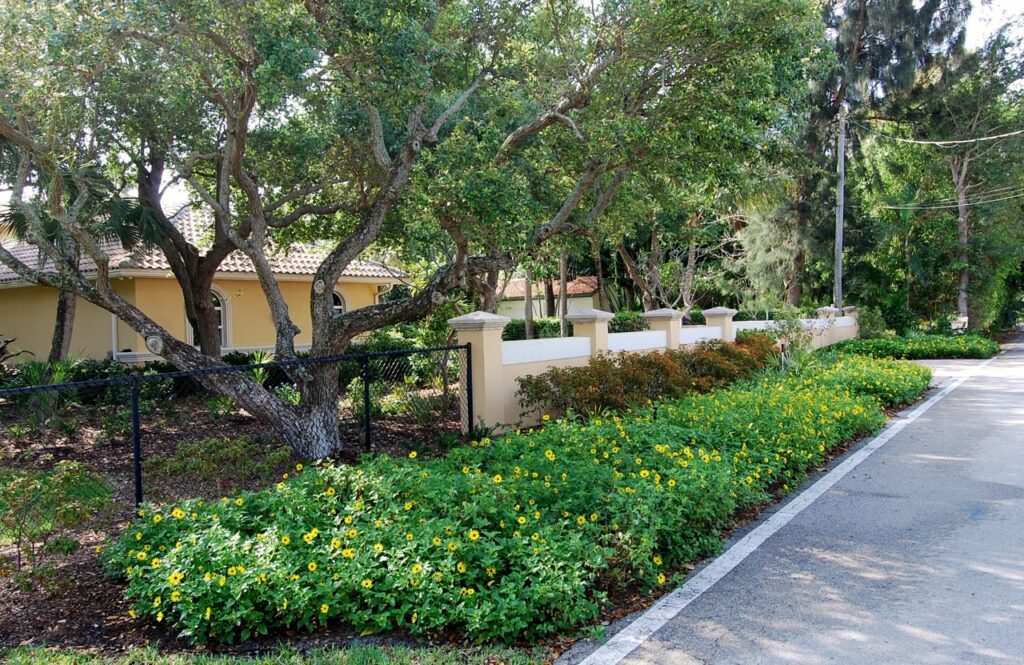
Bob Front of Drive at Three Months
After just three months, the entranceway is full of color provided by Firebush and Dune Sunflower.
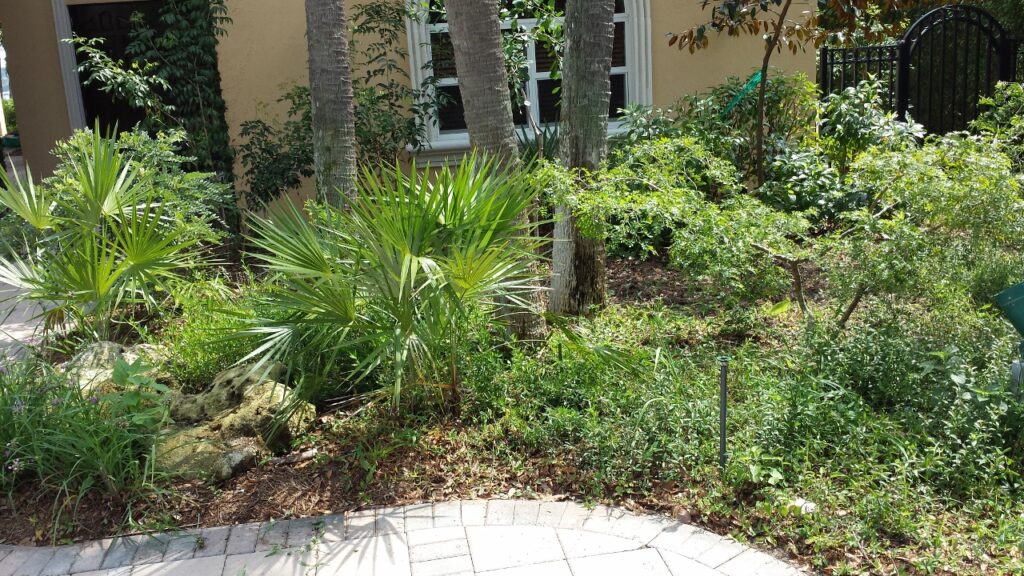
This is the front of a multi million dollar home on the intracoastal in Lantana. The plant on the front right is a Lignum Vitae and the palms are Key Thatch. Ground covers include twinflower, spiderwort and quailberry. The back right is a Satinleaf and the shrubs along the wall are Bitterbush on the left and Bahama Coffee on the right.
Let’s step out at 8:00 on a cool March morning and stop at the native strangler fig. 50 cedar wax wings have been feeding on its fruit for the last month. The tree has conveniently dropped its leaves to make the half inch fruit more visible.
A hummingbird picks insects off the fruit while blue jays, warblers, the blue-headed vireo, and pileated and downy woodpeckers stuff themselves.
Standing under a leafless strangler fig with the acid smell of decaying leaves, a cool breeze and dim morning light can transform you to a northern deciduous forest for a moment.
The native mulberry is just leafing out and is worth a stop. Although there are no fruit yet, several birds pass through the branches including a cardinal, hummingbird, blue gray gnatcatcher, pine warbler, and catbird.
A downy woodpecker squeaks as it hops through the branches. Maybe these birds are feeding on insects pollinating the flowers.
We planted native multiflora passion vine and hairy tournefortia next to a live oak. They have grown 30 feet up into the tree creating a blanket over the branches.
Zebra longwing and Julia butterflies lay their eggs on the passion vine and nectar on the tournefortia flowers. It seems like the dozens of butterflies will carry the tree off on sunny days when they are most active. Birds love the white berries which hang from the tournefortia most of the summer.
The three feeders for painted buntings are always occupied. One outside our patio has three males and a female in it. There is a cardinal on the bird bath and a squirrel on the ground.
The drip and mister over the bird bath is set for my lunchtime so that I can eat while watching the locals bathe from just ten feet away.
Tall, uncut fire bush provide berries and cover while my Jack Russell terrier “Susie “keeps the cats far away. No grass, just a path with naturally provided leaves as a groundcover.
The spring migration should be starting soon so get out your binoculars and identification books. This will be a good time to learn new birds until mid May when the winter residents and migrants leave for the summer.
Without our native pollinators, we would not find tomatoes, citrus, melons, mango and many other foods so easily and cheaply available in our stores.
Honeybees are native to India and are dying out due to several diseases that have recently followed them here. Killer bees will soon arrive and end backyard beekeeping. Fortunately there are other, even more efficient, native pollinators.
You may already know about hummingbirds, butterflies, bumble and carpenter bees and even bats as pollinators. The less commonly known include: lady beetles, thrips, wasps, flower flies, sap beetles, moths, some songbirds, solitary bees and the lowly opossum.
It’s fun to attract our local pollinators and it is kid friendly too. Solitary bees won’t sting unless handled and some don’t have a stinger at all.
Colony forming bees like honey bees, bumble bees and paper wasps will sting to protect the queen so don’t disturb the nest. Honeybees leave the stinger in you and die soon after. This is why they rarely sting if bothered while visiting flowers….they just move on.
To help various pollinators nest in your yard try the following: Turn a six-inch or larger clay flowerpot upside down under a bush for bumble bees to nest in.
Leave some small areas of bare ground. The three-eighths inch bright green halictid bee will dig a tiny volcano-like hole in the ground here.
Drill quarter-inch or more diameter holes, two inches deep into posts or blocks of wood for the black mason bee to nest in. Also, hang horizontally a bundle of paper straws with a plastic roof for this bee.
Rotted tree stumps, old dry stalks, muddy soil, dead wood, wildflowers and reduced or no insecticide use are ways to build up a nice population of pollinators.
Get rid of some grass and restore your yard with natives. You will find that your fruit trees yield better and that the shrubs, which you have planted to provide berries for your songbirds, will fruit abundantly.
I have found that kids love watching the swarms of pollinators that are attracted to the blood berry bush, Cordia globosa. This native likes dry soil and has small nonpoisonous berries that the birds like too.
Some of our native shrubs are adapted to fire in the natural habitats that they occur in. They are burnt to the ground every three years and become rangy when not.
Beautyberry and necklacepod are prime examples. Our county’s natural areas are often managed with fire, yet I wouldn’t suggest this at home. Instead, you will need a good pair of loppers, a bow saw, and clippers.
Shrubs that benefit from severe pruning include: beautyberry, firebush, wild coffee, necklacepod, fiddlewood and native wild plumbago. If you don’t want to prune to the ground then leave a foot or two.
This can be done every three to five years. Prune Jamaica caper, crabwood, marlberry, myrsine and the stoppers only to shape them if necessary the first few years and then leave them to grow tall and full thereafter.
If you decide to make a hedge out of your shrubs, please don’t square them. This removes most of the flowers and fruit and looks unsightly.
I personally like a mixed hedge with different heights, leaf shapes, and color of foliage and best of all, a progression of fruit to keep the full time birds and migratory birds well fed.
Just go to one of our natural areas and notice which plants grow together. Along the coast you will find Spanish stopper, wild coffee, Jamaica caper, marlberry, saw palmetto, myrsine, wildlime, and beach cocoplum all growing in a beautiful mix. Throw in some firebush and you will have year-round fruit and flowers.
By the middle of August you may see the first migrating warblers, followed in September by hummingbirds, and painted buntings in October.
Plants that fruit in late summer and early fall include Jamaica caper, beach cocoplum, elderberry, saw palmetto, spicewood, Bahama strongbark, Simpson’s stopper, and Walter’s viburnum. Their berries will greet the new arrivals.
A healthy, naturally shaped shrub will produce more fruit and cover for wildlife and look much better than when squared.
Kill grass underneath and mulch over it, (no need to pull it up), and you won’t have to worry about the bark of your shrubs and trees being torn off by the gardener’s weed- eater.
Plant in front of your mixed hedge with low wildflowers including: sunshine mimosa, dune sunflower, pineland petunia, coontie, beach creeper or love grass. Even corky passionvine makes a nice ground cover and is a larval food for three butterflies.
If your native plants look their best, your neighbors will want them also. Imagine a neighborhood full of birds and butterflies and so little lawn that water use is no longer an issue.
Don’t forget the quiet that idle lawnmowers and blowers will bring.
Spiders! Spiders! Spiders!
Don’t ask me to pick up a spider. Yet, the more I learn, the less I want to crush them. Did you know that spiders don’t drink your saliva, bite you or crawl in your mouth and get swallowed as you sleep?
If one is found in your tub or sink, it fell in from above while looking for water and didn’t crawl up from the drain. In fact if you handle spiders, you are very unlikely to be bitten. The bite of most spiders won’t do any harm although some may hurt for a minute.
Please learn the appearance of the brown recluse and both adult and immature black widow spiders because their bite requires a trip to the doctor.
Old furniture, piles of damp clothes, shady spots like old shoes left on the porch or cracks over the doorway are where the brown recluse and or black widow spider may be found.
This is a great way to get your teenager to stop creating that composting pile of clothes on the floor of their closet. “Clean up your mess or the brown recluse will crawl out and bite you.” Then you can feel safe in the company of the other dozens of harmless species.
Spiders are glad to get away from you, so let them. The big three which include the wolf, huntsman and nursery-web spiders may wander into your house or park themselves just outside the door and catch roaches and other unwanted pests before they can enter.
Although these are large, brown, scary looking spiders, their bites are not dangerous and if you learn where they hang out, the two of you can get along without any late night surprises.
Leave the brown, pea-sized house and long legged cobweb spiders to rid your house of mosquitoes and flies. Just clean up the old webs once in awhile but try not to end up throwing these guests out into the yard or they will die. They are adapted only to the indoors.
Beautiful spiders that you may find in your yard include the three inch orange and black golden-silk and the brown large orb weaver. Both spin fascinating webs across branches.
The very common crablike spiny orb weaver is white with black spots and red points along the edge. Mabel orchard spiders are one inch long, thin, with shiny silver and black stripes and red spots.
The inch or more green lynx spider sitting on a flower has no web and simply pounces on its prey. Her egg case is nearby and may be surrounded with tiny baby spiders.
You do have a choice between hiring a chemical company to nuke your home of all intruders and biological control with friendly spiders.
Outside, spiders are a major source of food for birds. They often make up 90 percent of a birds protein source.
Now if a spider crawls up beside you, just relax and watch her crawl away. It’s really not hard to resist the urge to step on it. Really! It’s not hard….I tell myself.
Seasonally wet areas of your yard are breeding grounds for our native frogs and toads.
The rain may have made parts of your yard wet for the last few weeks but this is good for our native insect eating amphibians.
Just two weeks of standing water will provide the tadpoles of several species of frogs and toads enough time to grow to adulthood. Tadpoles eat algae and the adults eat lots of mosquitoes and other insects.
The cacophony of calls at night is fun to listen to and teaches kids the value of preserving even the smallest of wetlands.
Fortunately the giant bufo toad and the Cuban tree frog don’t use short-lived wetlands for breeding. Both of these introduced species eat our native frogs. When was the last time that you saw a green tree frog?
The corner of your yard that floods can be planted with duck potato, spartina grass, blue flag iris and yellow canna lilies. These will provide hiding places for the tadpoles, and beautiful flowers for you.
After a heavy rain, several species of frogs and toads will come here. These include: the green and the squirrel tree frogs, florida cricket frog, little grass frog, southern chorus frog, and eastern narrow-mouthed frog which has a bleating call like a sheep.
The toads will fill the air with a mixture of funny sounds. These include: the eastern spadefoot toad with a low-pitched crow-like call; the smallest North American toad, the one and a quarter inch oak toad, which has a high-pitched whistle; and my favorite, the southern toad.
This fellow has a high-pitched trill, which at close range makes the insides of my ears rattle. He can be told apart from a young giant toad by the two knobby crests on his head, a light stripe down the middle of his back and the way that he hops a few times and then stops.
The giant toad hops quickly until it finds cover and has very large poison glands on both sides of its head. I dispose these large toads whenever I see them. The Audubon Society Field Guide to North American Reptiles and Amphibians is a great identification book.
It can be a real adventure to go out at night with a flashlight and identify frogs and toads that are breeding in your flooded areas. Kids will love it.
These amphibians are just the start of the food chain that leads to good snakes, hawks, owls and other interesting creatures.
Why fight wet areas of the yard with drainage pipes, fill or ditches? Wet areas can be the most interesting places in the yard and offer hours of exploration time for curious kids.
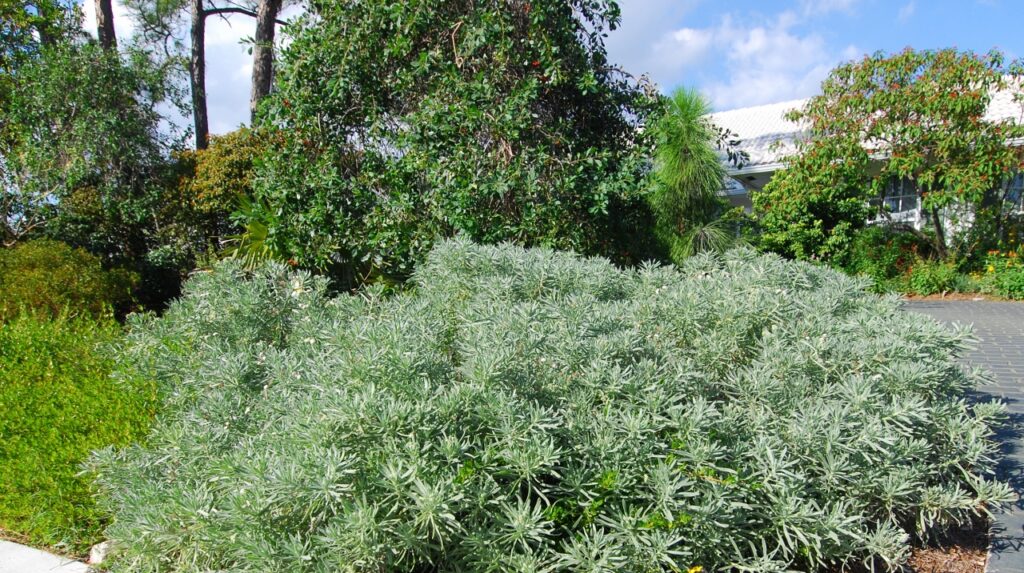
Sea Lavender in Buffie’s Front Yard
The planting along the road includes Sea Lavender, Beach Creeper, Coontie and Pineland Croton. These Sea Lavender grew to this size in about two years. Yearly light pruning keeps them compact and full. The Beach Creeper can be sheered with a hedge trimmer once a year to 12 inches. It will stay compact and golden with this small amount of maintenance.
You may want to keep your ground covers a couple of feet in from the road and have mulch where you’ll stand while cutting and weeding.